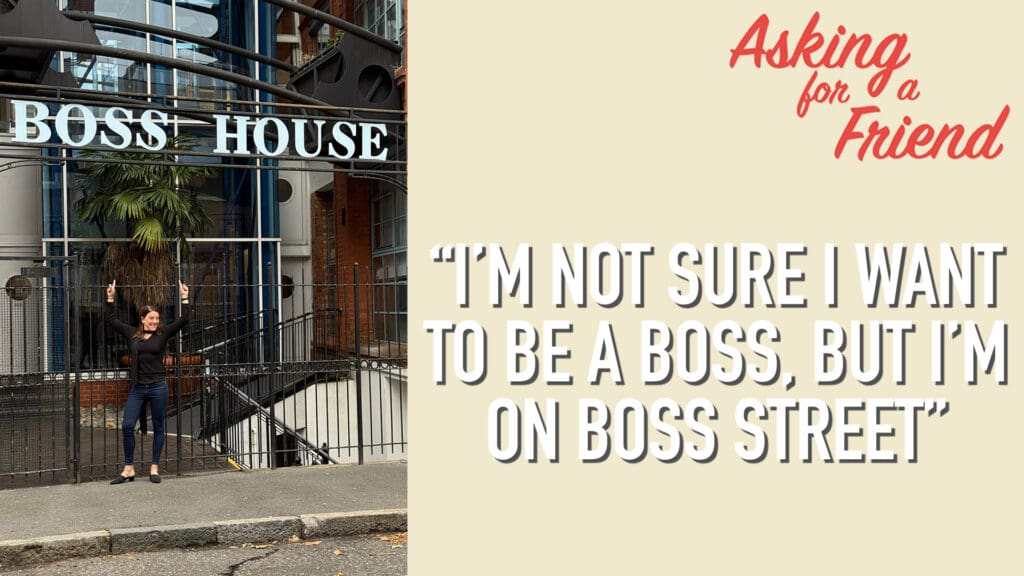Exploring the S Curve of Employee Growth
In this week’s Asking for a Friend, I speak with Whitney Johnson, author of Smart Growth, about how to support your team along the S curve of employee growth.
When I read Whitney’s new book, I was struck by how her model reflected my own journey of taking the leap from Verizon Wireless executive to entrepreneur.
You’ll want to watch the interview, particularly if you, or someone you care about, feel called to take on a new challenge, or are particularly stuck or stagnating in your career.

The S Curve of Employee Growth
Whitney talks about three main phases of growth: the launch phase, sweet spot, and mastery. In the launch phase, you take on the role of “explorer” and “collector,”—you’re not committed to taking on a new challenge full steam at this point. But, you’re learning about the possibilities of this new adventure and if it’s right for you.
Then in the sweet spot, you learn fast and your performance accelerates. Key roles in this phase of the game are “accelerator” and “metamorph,” where you BECOME your aspiration. This all makes real sense to me. I distinctly remember that moment I realized I was doing more than writing, I had become a writer.
And in the final phase, mastery, you’re confident and tested, and beginning to look around for what’s next (the next S curve for your personal or employee growth.
Bonus Track: Six Questions to Ask Yourself in the “Explorer” Phase
As I was reading Whitney’s book, I kept smiling through the “six questions to ask yourself in the explorer phase.”
So as a “Bonus Track” I share them as it relates to the “explorer” journey I began a decade ago, which turned into Let’s Grow Leaders (if you’re just tuning in here’s the backstory with a side of love story.)
As it turns out these are almost the exact questions I asked myself at that time.
1. Is it achievable?
Once my leadership blog started gaining traction, I began paying attention to who else was in this human-centered leadership space. I reached out to every leadership blogger I could—talking with them about their approach, their challenges, and most importantly, what they were doing that led to success. As I found my human-centered leadership voice, I began to more fully understand my unique gifts and what differentiated me from others in this space. That discovery brought confidence.
2. Is it easy to test?
Apparently, this one came from my subconscious. I was exploring before I was exploring. When I started my Let’s Grow Leaders blog on Sunday morning, I had no intention of testing my ability to start an international leadership development company. I just knew I had something to say, and began to write it down.
The funny part of this story is that I “shipped my art” (my really crappy first blog) to Seth Godin that morning. AND HE WROTE BACK.
I will never forget that generosity of encouragement to get me started.
3. Is it familiar, yet novel?
One hundred percent. The first decade of my career (and all my formal education) was about leadership development and communication. AND then, I became a large team operations leader. I’ve lived what I yearned to teach. I had taught leadership decades before in my HR roles. I knew how to build and operationalize high-quality leadership programs (and sell them internally to internal stakeholders). And also importantly, I knew how to measure their impact on bottom-line business results.
4. Does it fit my identity?
Totally. And, I had to laugh, at age 22 I thought I was ready to start my own LLC (called values and visions). I didn’t have the education, experience, or skills to do that … YET … Although, I just checked my tax returns. I netted $500 in that endeavor 😉
5. Is the pursuit worth the cost?
Every single human I talked with told me the financial risks were insane. (Except for one random dude who came up to me after a keynote I gave that first year. He challenged my, “I’m prepared to make less to pursue my dream,” with “Why do you assume that?” He was right.)
But the truth is, I was prepared to sacrifice some financial security to make a deeper impact on the world. And it was really hard the first few years. There were many days I wasn’t sure it would work. I gave myself a “How much I’m willing to lose?” deadline (I came within a hundred bucks of that.)
A huge joy is that we can now give back profits from every program to our Winning Wells program, building clean water wells in Cambodia.
6. Does it align with my values?
YES! And that’s the real joy. I’m one-hundred percent confident I was put on this planet to grow leaders as a leader, a parent, and through our leadership development work around the world.
Smart Growth Interview Highlights
Growth is our default setting.
2:40 I share a story from Whitney’s book. A 56 year old shared how tired he was, and the lack of engagement he is currently feeling. While written way before the pandemic, it applies now. There’s a reason Adam Grant’s article on “languishing” was the most-read New York Times article of the year.
Growth is our default setting.
We may feel we have a good life, but if we aren’t thinking of growing anymore, go deeper as to what may be happening to our sense of engagement.
What do you need to do to rest and restore?
Source of inspiration
5:30 What has been a source of inspiration for Whitney and her own engagement?
Whitney has found strength in her faith tradition, and not abandoning it during the pandemic.
Working on writing a book and having a meaningful project.
The S Curve of Learning
7:50 We discuss the S curve of learning (based on a Diffusion Curve).
Whitney used this to explore a hunch about growth and engagement
Launch Point
Your brain is running a predictive model.
Many times those predictions are incorrect, and you are in new territory which is taxing.
You might feel overwhelmed in this phase and growth feels slow.
Sweet Spot
10:24 The Sweet Spot
Your predictive model is getting increasingly accurate
You are starting to feel energy and engagement
Growth is fast
Mastery
10:50 Mastery
You’ve figured it out
Your growth slows down
12:22 How do you coach someone who is in mastery?
Anchor – once you’ve accomplished what you set out to do, take time to honor it. Review what worked and the habits that got you there.
Mountain – What now?
Is this “A” summit or “THE” summit?
My team is on a variety of spots on the curve of employee growth. How do I help them all?
21:00 How do I help my team with their engagement and development?
You can manage your team as a portfolio of S curves
Optimizing your team for growth benefits from a variety of points on the curve
For example, those at the launch point need support, encouragement, training, resources, and you value their inexperience. Their questions can lead to innovation.
22:46 How do you help those who have reached mastery and aren’t interested in a new launch point.
Have an S curve discussion with them.
Remind them that learning is the oxygen of human growth.
Make a plan for continued growth to the point of their retirement/resignation.
Encourage them to leave an example and legacy.
Point out what they will lose if they stay stagnant
25:30 How do you help Millenials/Gen Z’s embrace a challenge?
They likely noticed other generations working very hard – almost too hard. They want to grow but not just at work.
Don’t be resentful, but be direct in what they need to do to be successful.
Humans like freedom, but we also like boundaries. Be flexible on where/when/how but very clear on what needs to be done.
Last piece of advice about personal and employee growth.
27:55 Last piece of advice
The purpose of the book is to give you a very simple, visual model of what growth looks like. When you have a map, the more you can grow.
If you like this Asking for a Friend on Inspiring Employee Growth, you won’t want to these:
How to Help My Team Make the Most of Failure (Colin Hunter)
How do I have more impact and influence at work (Liz Wiseman)
Development Discussion Planner (Free Tool) How to Prepare for a Better Development Discussion








0 Comments